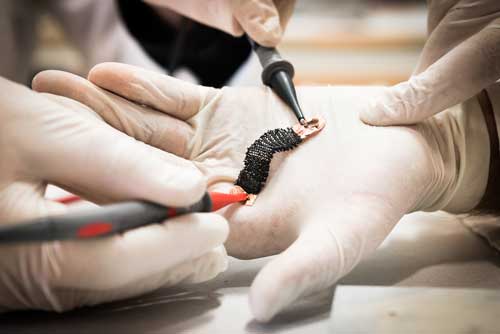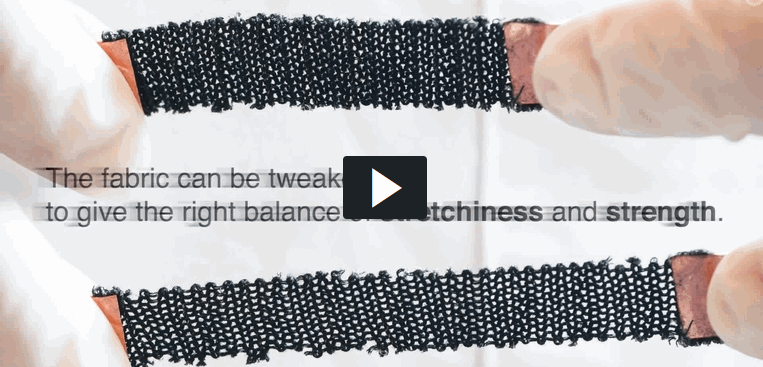
Researchers have coated normal fabric with an electroactive material, and in this way given it the ability to actuate in the same way as muscle fibres. The technology opens new opportunities to design “textile muscles” that could, for example, be incorporated into clothes, making it easier for people with disabilities to move.
The study, which has been carried out by researchers at Linköping University and the University of Borås in Sweden, has been published in Science Advances.

Developments in robot technology and prostheses have been rapid, due to technological breakthroughs. For example, devices known as “exoskeletons” that act as an external skeleton and muscles have been developed to reinforce a person’s own mobility.
“Enormous and impressive advances have been made in the development of exoskeletons, which now enable people with disabilities to walk again. But the existing technology looks like rigid robotic suits. It is our dream to create exoskeletons that are similar to items of clothing, such as “running tights” that you can wear under your normal clothes. Such device could make it easier for older persons and those with impaired mobility to walk,” says Edwin Jager, associate professor at Division of Sensor and Actuator Systems, Linköping University.
Advantages of lightweight and flexible fabrics
Current exoskeletons are driven by motors or pressurised air and develop power in this way. In the new study, the researchers have instead used the advantages provided by lightweight and flexible fabrics, and developed what can be described as “textile muscles”. The researchers have used mass-producible fabric and coated it with an electroactive material. It is in this special coating that the force in the textile muscles arises. A low voltage applied to the fabric causes the electroactive material to change volume, causing the yarn or fibres to increase in length. The properties of the textile are controlled by its woven or knitted structure. Researchers can exploit this principle, depending on how the textile is to be used.
The article: Knitting and weaving artificial muscles, Ali Maziz, Alessandro Concas, Alexandre Khaldi, Jonas Stålhand, Nils-Krister Persson, Edwin W.H. Jager, Science Advances, published online 25 January 2017, doi: 10.1126/sciadv.1600327
“If we weave the fabric, for example, we can design it to produce a high force. In this case, the extension of the fabric is the same as that of the individual threads. But what happens is that the force developed is much higher when the threads are connected in parallel in the weave. This is the same as in our muscles. Alternatively, we can use an extremely stretchable knitted structure in order to increase the effective extension,” says Nils-Krister Persson, associate professor in the Smart Textiles Initiative at the Swedish School of Textiles, University of Borås.
Integrating textile muscles into items of clothing
The researchers show in the article that the textile muscles can be used in a simple robot device to lift a small weight. They demonstrate that the technology enables new ways to design and manufacture devices known as “actuators”, which – like motors and biological muscles – can exert a force.
“Our approach may make it possible in the long term to manufacture actuators in a simple way and hopefully at a reasonable cost by using already existing textile production technologies. What’s more interesting, however, is that it may open completely new applications in the future, such as integrating textile muscles into items of clothing,” says Edwin Jager.
Learn more: “Knitted muscles” provide power
[osd_subscribe categories=’exoskeleton’ placeholder=’Email Address’ button_text=’Subscribe Now for any new posts on the topic “EXOSKELETON”‘]
Receive an email update when we add a new EXOSKELETON article.
The Latest on: Textile muscles
[google_news title=”” keyword=”textile muscles” num_posts=”10″ blurb_length=”0″ show_thumb=”left”]
via Google News
The Latest on: Textile muscles
- A smart neckband for tracking dietary intakeon May 8, 2024 at 9:35 am
A smart neckband allows wearers to monitor their dietary intake. Automatically monitoring food and fluid intake can be useful when managing conditions including diabetes and obesity, or when ...
- Best furniture deals ahead of Memorial Dayon May 3, 2024 at 10:07 am
Some of your favorite furniture retailers are currently hosting pre-Memorial Day sales you won't want to miss.
- 8 Best Apparel And Textile Stocks Of May 2024on May 3, 2024 at 5:16 am
For this reason, the retail sector, of which apparel and textile companies are a part, tends to move along with major indices like the S&P 500, although not necessarily to the same magnitude.
- Textile Artists Bring New Life to an 18th-Century Buildingon May 1, 2024 at 5:00 pm
Sheets In one of the oldest buildings in South Street Seaport in New York, more than 100 artworks by 61 artists using textiles inventively have taken over a former mercantile warehouse and its ...
- Story of Pasmanda Muslims against backdrop of PM Modi's speechon April 25, 2024 at 11:25 am
The politics of othering is failing all of us. Poor and Pasmanda Muslims have suffered the most due to these divisive and hateful politics and directionless economic policies.
- textile: The Latest Architecture and Newson February 19, 2024 at 4:00 pm
In contemporary architecture, recycling has evolved from a desirable to an unavoidable necessity. This change is mainly due to the growing climate crisis, accentuated by the constant presence of ...
- Textiles and Clothing Newson October 25, 2023 at 5:00 pm
New Conductive, Cotton-Based Fiber Developed for Smart Textiles Dec. 11, 2023 — A single strand of newly developed fiber has the flexibility of cotton and the electric conductivity of the ...
- Sustainable Textile Technologies MScon May 5, 2023 at 3:12 am
Student Nadir talks about his experience studying Textile Design, Technology and Innovation at DMU. *This course was previously called Textile Design, Technology and Innovation This course will ...
- How do I store antique textiles at home?on January 11, 2023 at 12:52 pm
It is also best to set aside one drawer or chest of drawers just for the storage of family heirlooms. 1. Textiles should be stored as clean as possible because dust particles can actually cut fibers ...
via Bing News










